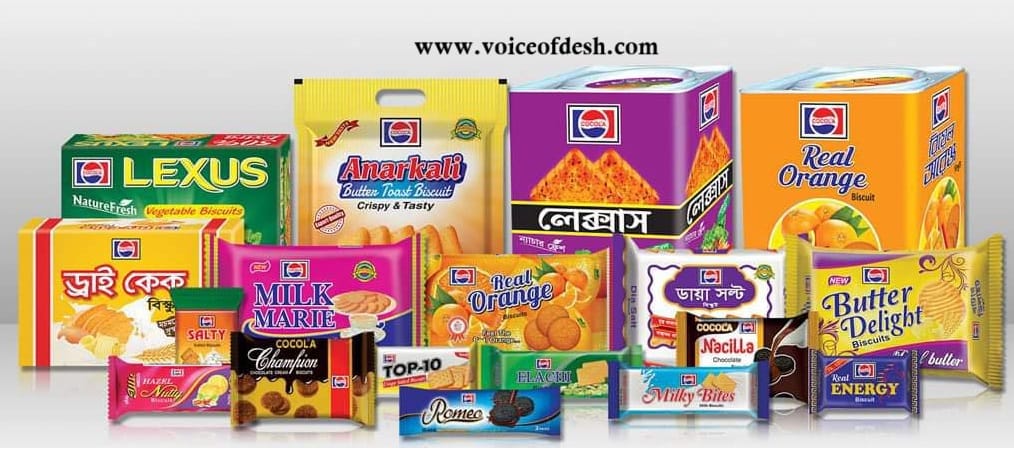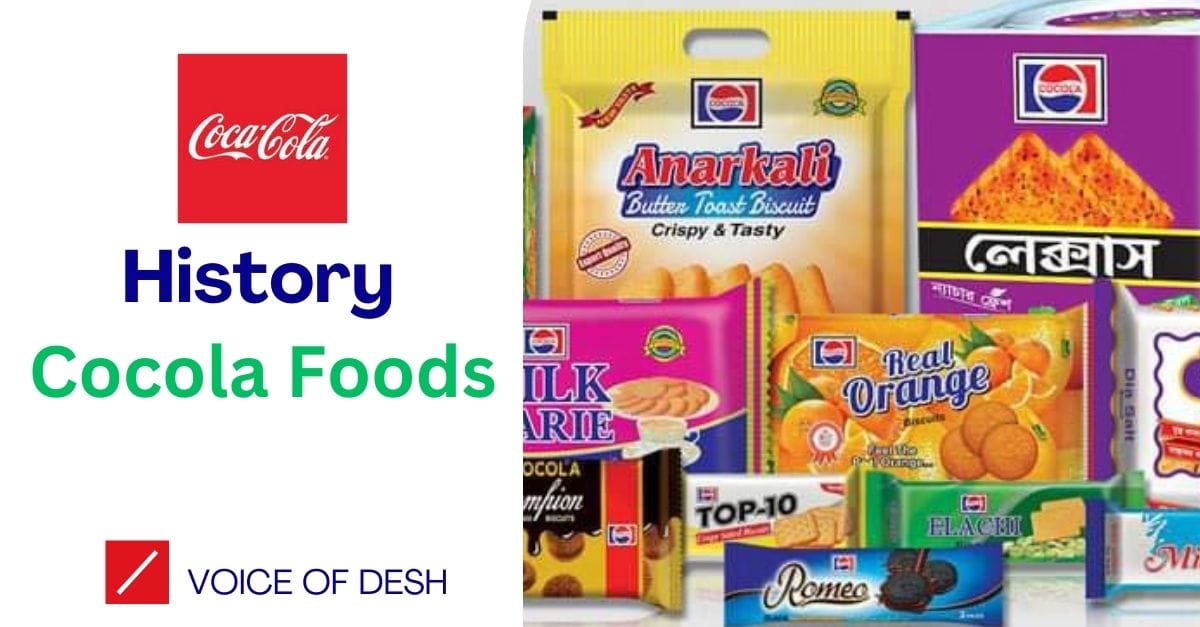Cocola Foods
The necessity of pure food in the minds of Bangladesh consumers especially in the commodity food business has pushed COCOLA to fill up the market demand by producing food products such as snacks, confectionary etc. COCOLA is engaged in manufacturing, marketing, and distribution of various branded food products and condiment. Now the customers of Bangladesh are ensured with 100% pure food products under the brand name of ‘COCOLA’. Within the very short period of its entrance this brand has been enjoying second leading position in the market.
Manufacturing Production
Products
Some of the products of Cocola Food Products Ltd. are:
Noodles: (b) Biscuits:
1. Cocola Egg Noodles 1. Cocola Champion Biscuit
2. Cocola 2 Minute Instant Noodles 2. Vita Plus Biscuit
3. Cocola Cook Noodles 3. My Protein Marie Biscuit
4. Cocola Mojadar Egg Noodles
Candy & Chocolates: (d) Wafers:
1. Gems 1. Banana Wafer
2. Fruit Candy 2. Chocolate Wafer
3. Kiss Candy 3. Pineapple Wafer
4. Lichi Chocolate 4. Milk Mini Wafer
5. Milk Fruity 5. Chocolate Roll Wafer6. Milk Candy
Chips: (f) Drinks (Non-Carbonated)
1. Potato Chips 1. Fruity Cup
2. Caramel Corn Crackers 2. Lichi Gel
3. Twister – Tomato Flavor
Two types of noodles are available in the Bangladeshi market. They are:
i. Instant Noodles
ii. Air Dried Noodles
i. Instant Noodles:
Instant noodles come with a packet of flavoring called tastemakers. Instant noodles are eaten after being cooked in boiling water for 3-5 minutes and added with tastemaker.
The market size for instant noodles is 4000 tons (approx.) which is equivalent to 45% of the total noodles market.The current market leader in this segment is Maggi by Nestlé with a market share of 57% (Oct ’08). Source: Nielsen
ii. Air Dried Noodles:
Air dried noodles, also referred to as traditional noodles, is first boiled in water, then the water is drained and finally it is cooked with oil and other ingredients
like egg, vegetables, etc. The market size for instant noodles is 5000 tons (approx.) which is equivalent to 55% of the total noodles market. The current market leader in this segment is Cocola Egg Noodles with a market
History of Instant Noodles in Bangladesh
Cocola Food Products Ltd. introduced stick (air dried) noodles in Bangladesh in 1987. Instant noodles were first brought to Bangladesh by Fuji. It came with a tastemaker and a small packet of oil. Now oil is not given with any instant noodles due to packaging problems. Within a very short time, in 1997 Transcom Food brought Maggi Instant Noodles from Pakistan
Cocola Egg Noodles

Also known as the Cocola Stick Noodles in most of the markets, this has been the most
successful of all the Cocola noodles products. The unique thing about this product is the
preparation method. The Egg Noodles is made up of air dried noodles sticks. It naturally
comes with a single flavor and with two packaging (red outer line or yellow outer line,
red outer line being the more popular). According to Cocola and also its competitors,
this preparation method gives Cocola a competitive edge over all others, because none
of the other companies have as good machinery for making air dried noodles as Cocola
does
Cocola 2-Minute Instant Noodles
This is the instant noodles product of Cocola. A packet of instant noodles contains a
noodles cake and a flavoring known as taste-makers. Cocola Instant Noodles is available
in the market in two flavors – Chicken Masala and Beef. The taste-maker is actually
produced in Japan but they are imported from Singapore. The preparation method for
this type of noodles is completely different from that of the air dried noodles
Cocola Cook Noodles and Cocola Mojadar Noodles
These products are comparatively new in the market. Both of them contain the same
type of noodles but in different packages and different sizes. The Cook Noodles is of a
larger size, mostly for families. The Mojadar Noodles is of a smaller size. The noodles
cake that is used is similar to the instant noodles in shape but contains air dried
noodles. So, although they have the same appearance as the instant noodles, the cooking
method and taste are different because of their production method.
Sales and marketing
Market Review
Overview of the Noodles Market
The market size for noodles is 9000 tons+ per year (Approximate). Two types of noodles are available in the Bangladeshi market. They are:
Instant Noodles
Air Dried Noodles
Market Needs
The basic needs of the instant noodles market are quick preparation time, tasty and
healthy product, and a certain variation of tastes, which means different flavors. These
needs can be further put into categories based on the use and preparation of the instant
noodles.
In Bangladesh, we use instant noodles mostly for lunch break or snack purposes for the
children as well as for other members of the family in school, work and at home
Marketing
Nestlé has a massive marketing budget worldwide. It can cover Bangladesh market by
placing advertisements on Indian TV channels like Cartoon Network, Star World, etc. In
Bangladesh, Maggi has become the other name for instant noodles. Nestlé Bangladesh Ltd. provides shelves invarious supermarkets and has good delivery system.
Goals
Be the no.1 preferred snacks in Bangladesh for children aged between 10 to 12 years To become no.1 preferred snacks for all kids in the country Establish Maggi as the best tasty and healthy noodles (for children), which cannot becompared
Competitive Position
Nestlé is finding it very easy as the market leader in this category with its brand Maggi.
Maggi has successfully captured market share, mind share and heart share of its target
market. When Cocola slashed its price by Tk. 2, Maggi’s sales was unaffected.
Fu-Wang Noodles
Fu-Wang Noodles is the market challenger with 19%market share. It is owned by Fu-Wang Foods & Beverage Ltd. in Bangladesh. They import tastemaker from Taiwan.
Their noodle is to be cooked for 3 minutes not for 2minutes like the other instant noodles. Consumer Identifying the Target AudienceThe process must start with identifying a clear target audience in mind: potential
buyers of the company’s products, current users, deciders, or influencers, individuals,
groups, particular publics, or the general public.
The main target audience for Cocola Instant Noodles should be children (7-12 years)
and mothers.
Buyer Readiness Stages
Based on the buyer readiness stages it can be said that a large part of the target
audience for CIN are in the awareness stage. They do know about Cocola Egg (Stick)
Noodles but they do not known reference is not affected though.
Deciding on Promotion Mix:
o Above the Line (ATL): Promotional activities carried out through mass media, such
as television, radio and newspaper, are classed as above the line promotion. Thesetypes of advertising are costly. But since building brand awareness is one of themajor promotion objectives in case CIN, ATL promotion cannot be neglected.
TV Advertisements
Print Advertisements (newspaper, magazines)
o Below the Line (BTL): Below the line sales promotions are short-term incentives,
largely aimed at consumers. With the increasing pressure on the marketing team to
achieve communication objectives more efficiently in a limited budget, there has
been a need to find out more effective and cost efficient ways to communicate with
the target markets. This has led to a shift from the regular media based advertising.
BTL techniques ensure recall of the brand while at the same time highlighting the
features of the product.
Forms of BTL Promotion to be used:
i) Free Sampling in district level schools and amusement parks
ii) Gift with Purchases: Paper toy with 2 single packets & tiffin box with (5+5)
10 packets
iii) Trade discount to retailers & business customers
iv) At Point of Purchase: Danglers, posters, separate CIN shelf at superstores
(e.g. Agora, Nandan etc) with trained shelf talkers.
v) Provide discount coupons with flyers in district level schools and
amusement parks to induce trial
• Alternatives Price/Quality – Maggi and Fu-Wang can be both termed as alternatives.
Maggi is superior in terms of quality, but Fu-Wang and Cocola have more or less the
same quality. The prices of the products are similar.
• Fashion and Trends- There has been changes in food habits of the populace, mostly
those living in urban and semi-urban areas. Previously egg noodles and stick noodles
were more popular. Recently, both due to easy preparation method and sales
promotion, instant noodles is also getting more and more popular.
• Legislative Effects- The products need to be tested and certified by BSTI for quality
and hygiene.
Buyer Power
• Buyer Choice- In this case, buyers can choose from Cocola, Maggi, Fu-Wang and
Meridian for instant noodles and also a few of the local homemade brands of stick
noodles.
• Buyers Size/ Number- The number of buyers is quite huge, because a lot of people
are interested in noodles, and the target market is getting bigger and bigger every day.
The companies normally target the people having a fair income and can afford to
purchase snacks.
Competitive Rivalry
• Number and Size of Firms – Major competitors like Maggi and Fu-Wang are established firms. Although Meridian is not very popular, Maggi is. Maggi is both very
well known and has a very big market share. Industry Size and Trends – The industry itself is substantially big and is showing a
growing trend. Noodles, as a food and snack, is getting more popular among the lower
end of the urban and semi-urban societies.
• Product Ranges- Cocola Stick Noodles itself acts as a competitor for the Cocola
Instant Noodles. In rural areas, Cocola is quite popular, because of its Stick Noodles, but
not because of its Instant Noodles, for which Maggi is popular.
Economic Environment
Instant noodles are a growing product and thus price should be competitive to capture
market. The economic factors we find relevant to instant noodles are:
Global price surge is heating up edible oil market. In 2008, the price was Tk 87-90ü
per litre1. This year, the price has come down to Tk 60 per liter, which is still high.
Instant noodles contain a cake already baked in oil and thus require no additional
oil.
More women are availing employment opportunities and working mothers will help
drive the demand for ready-to-cook snacks.
As Bangladesh is undergoing extensive industrialization, many household maids are
leaving their current jobs and entering the factories for better salary and better
social status leaving homes to be tended by part-time helps or by the families.
Global recession is causing prices of essential items to go down and making
complimentary snack items more affordable.
Social and Cultural Environment
Social factors will affect customer’s needs and perception of what they want and thus
shape potential market for our product. The social factors we see affecting our product
are:
There is a trend of both parents working in all social classes leaving the children to tend for themselves and instant noodles can be cooked by practically anyone who knows how to boil water.
Technological Environment
Currently, the technological environment is not directly affecting the demand for instant
noodles. The technology to produce instant noodles is acquired from experts from
Taiwan, Japan and other countries.
Political and Legal Environment
The political environment has been an influence in promoting certain brands for
government offices. Currently, government offices do not demand noodles as they have
their own canteens. Legal side of this product would include complying with the
Bangladesh Standard Testing Institute (BSTI). That would include providing the correct
information on the packaging label about nutritional facts.
Goals and Objectives
The primary goal of Cocola is to increase its market share in the instant noodles market
in Bangladesh. The product is in its growth stage with annual growth of 40%. At this
stage, Cocola is basically a follower imitating Maggi’s instant noodles in some ways. Its
tastemaker is a mixture between soup flavors with basil leaves and is less spicy
appealing to those with low tolerance for chili. The marketing mix strategies are
discussed in the next section. In the first year, Cocola aims to capture 25% of the market
share from its share of 18% share now.
First, awareness building programs will be undertaken starting from July 2009. This will
include promotion mix strategies .
Human Resources
Training distributors/Sales representatives
In order to create a good image for itself, Cocola must have good sales representatives
who will be more efficient and delicate in selling its products. They will be trained more
on how to properly market the products to different types of retailers along with facing
different behavioral patterns from them. This will enhance the number of sales to retail
Process
Process consists of the customer experience creating activities. People can buy noodles
from any of the distribution channels through which the product is being supplied. In
the supermarkets they receive no supervision and thus there is limited scope for
creating experience.
However, there are two specific promotion campaigns and one Below the Line (BTL)
labeling strategy to address this. Also, there other strategies which are meant to make
the process of consuming noodles enjoyable.
Action Programs
The product will be re-launched with a new taste maker. The positioning message will be made clearer through push strategies initially and aim at capturing the soul share. By providing quality hygienic noodles, CIN will try to gain 25% of the market share up from the current market share of 18% in the next one year. The entire project is flexible and thus test marketing has been prepared which initial survey of people show that they will go back to Cocola if the taste was good.
1. Taste maker modified re-buy from Malaysian suppliers so that the ingredients have a better taste. (They had tried with Taiwanese taste maker before.)
2. Packaging from yellow and red to the popular Cocola Stick Noodles packet design though size will be same as before.
3. Clearing inventory of old CIN packages.
4. Training to agents to have better B2B relationships and retailer relationship.
5. Carry out test marketing.
6. Special trade terms modified to reduce commission of agents as we go for a pull strategy.
Job Responsibilities:
Develop and implement an annual agenda for HR strategy in line with the business plan.Maintain management guidelines by preparing, updating and recommending human resource policies and procedures.Prepare personnel forecast to project employment needs.Maintain organization staffs by establishing a recruiting, testing and interviewing program.
Ensure all staff receive appraisals in accordance with company policy and monitor probationary periods.
Academic Requirement: Masters in any discipline. However, candidates having higher diploma in HR management will get preference.
Required Experience: The ideal candidate should have 5 – 7 years of working experience in Human Resource Department at the corporate office of any reputed FMCG company. S/he should serve at least two years at managerial level during his/ her service period.











